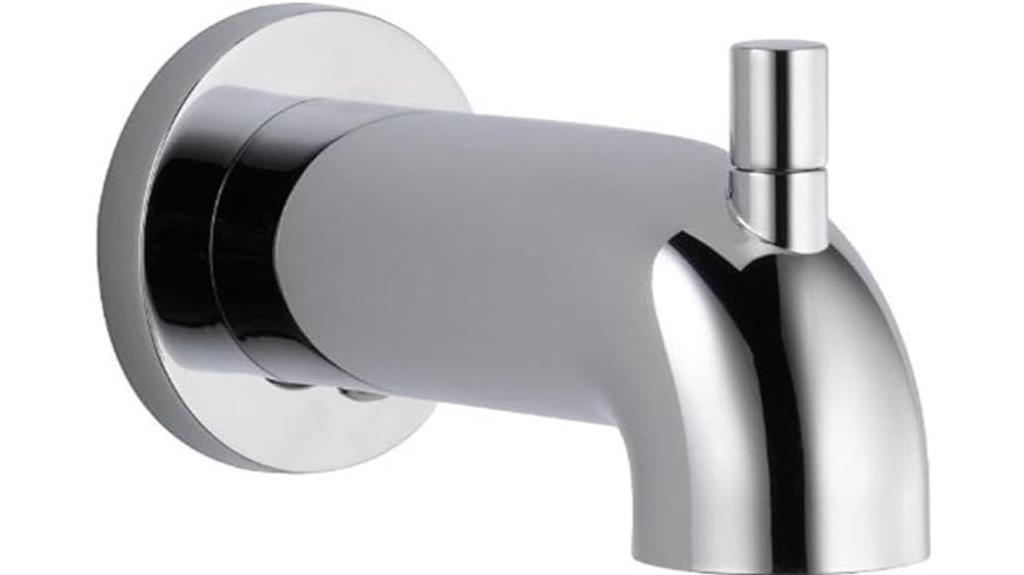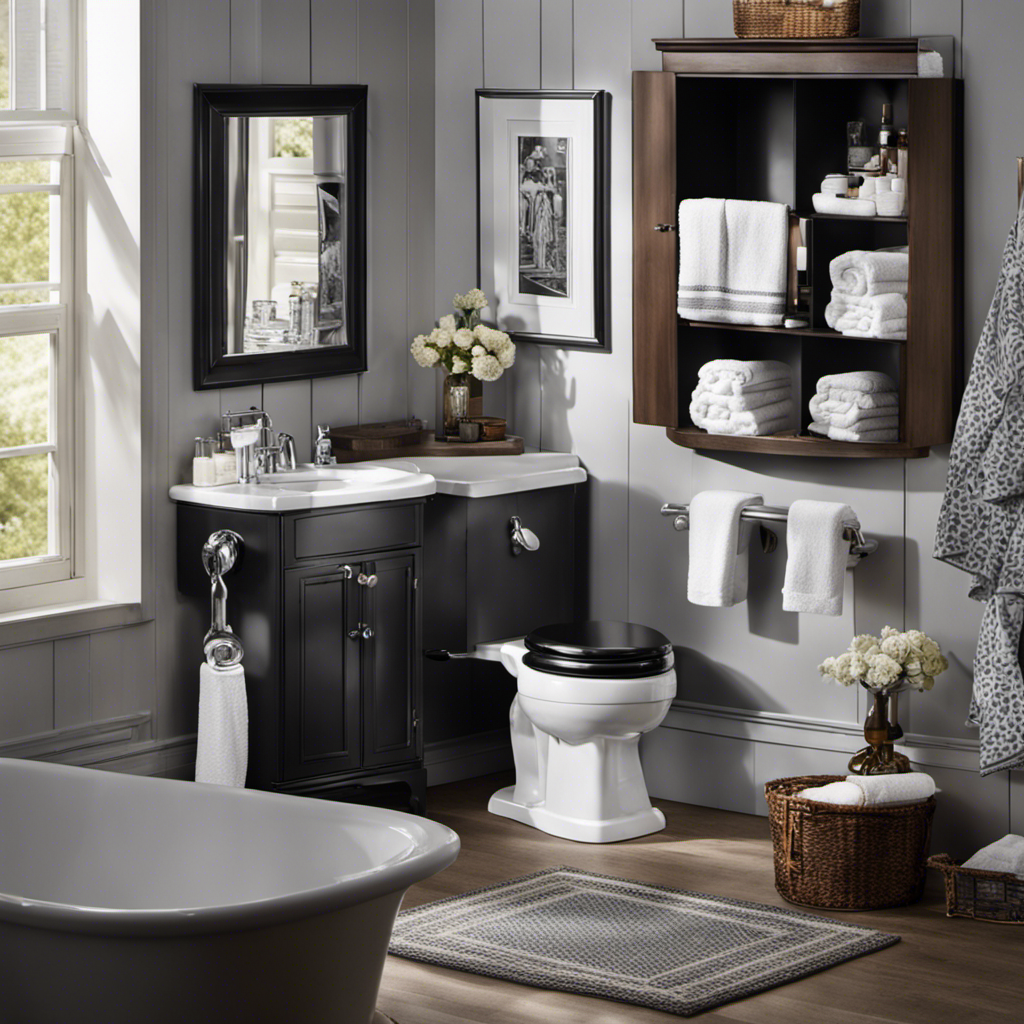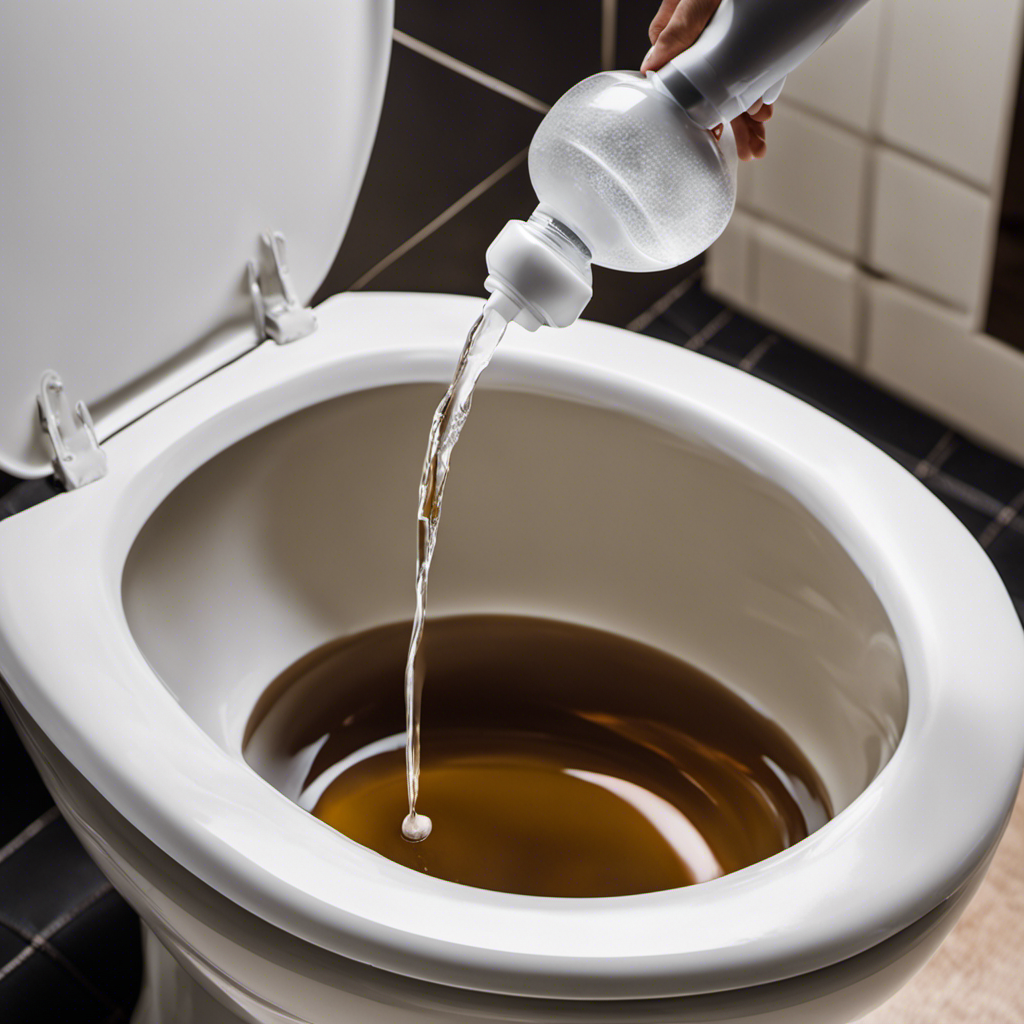I can’t even begin to describe the frustration of a broken toilet handle. It’s one of those everyday inconveniences that can turn your whole day upside down.
But fear not, because I’m here to guide you through the process of fixing that pesky handle step-by-step. With a few simple tools and a little bit of know-how, you’ll have your toilet handle working like new in no time.
So let’s dive in and get that toilet handle back in action!
Key Takeaways
- Check for loose handle and tighten nut if necessary
- Inspect lever arm for damage and replace if needed
- Examine chain for tangles or looseness
- Proper tool selection and maintenance is crucial for successful repair
Assess the Problem
First, you’ll need to assess what’s wrong with the toilet handle. Toilet handle troubleshooting involves identifying common handle problems.
Start by checking if the handle is loose or not functioning properly. If it feels loose, it may just need tightening. Simply remove the tank lid and locate the nut securing the handle to the toilet. Use a wrench to tighten it.
If the handle is not responsive or sticks when flushed, it may be due to a broken or bent lever arm. Inspect the lever arm for any visible damage and replace it if necessary.
Additionally, check if the chain connecting the handle to the flapper is tangled or too loose. Adjust or replace the chain as needed.
Assessing the problem is crucial before moving on to gather necessary tools for the repair.
Gather Necessary Tools
Before diving into the task of fixing a toilet handle, it’s crucial to gather the essential tools needed for the job. Proper tool selection plays a vital role in ensuring a successful repair, so it’s important to choose the right tools for the specific task at hand.
Additionally, maintaining the tools in good condition is equally important to ensure their effectiveness and longevity, so implementing proper tool maintenance tips is essential.
Essential Tools Needed
To fix the toilet handle, you’ll need a few essential tools. Here are the tools you’ll need for the job:
-
Adjustable wrench: This tool is used to loosen and tighten nuts and bolts, making it essential for removing and installing the toilet handle.
-
Screwdriver: A flathead or Phillips screwdriver will be needed to remove any screws holding the handle in place.
-
Replacement toilet handle: If your current handle is broken or not functioning properly, you’ll need a new handle to replace it.
-
Pliers: Pliers will come in handy for gripping and twisting any stubborn nuts or bolts during the installation process.
With these tools in hand, you’ll be ready to tackle any toilet handle installation or troubleshooting issues that come your way.
Proper Tool Selection
When selecting the right tools for the job, make sure to choose an adjustable wrench, a screwdriver, pliers, and a replacement handle.
Proper technique is crucial when fixing a toilet handle. To start, turn off the water supply valve to prevent any water leakage.
Next, use the adjustable wrench to loosen the nut connecting the handle to the toilet tank. Once the nut is removed, take out the old handle and replace it with the new one. Make sure it is securely fastened by tightening the nut with the wrench.
Troubleshooting tips: If the handle is still not functioning properly, check if the chain is properly attached inside the tank or adjust the float level.
Tool Maintenance Tips
For proper tool maintenance, it is important to regularly clean and oil your adjustable wrench, screwdriver, and pliers. This will help keep them in good working condition. Proper tool storage and cleaning techniques are also essential to prolong the lifespan and effectiveness of your tools. Here are some important tips to consider:
- Store your tools in a dry and clean area to prevent rust and corrosion.
- Clean your tools after each use by wiping them with a clean cloth to remove dirt and debris.
- Use a mild detergent and warm water to clean stubborn stains or grease from your tools.
- Apply a thin layer of oil to the metal surfaces of your tools to prevent rust and keep them lubricated.
By following these cleaning techniques and storing your tools properly, you can ensure that they are always in optimal condition for any task at hand.
Now, let’s move on to the next step: removing the toilet tank lid.
Remove the Toilet Tank Lid
When it comes to removing the toilet tank lid, there are several techniques that can be used depending on the type of lid and its attachment.
One common method is to locate the plastic or metal clips that hold the lid in place and gently pry them open using a flathead screwdriver.
Another approach is to unscrew the bolts or nuts that secure the lid to the tank using an adjustable wrench.
Once the lid is removed, it is important to consider the accessibility of the tank for any necessary repairs or maintenance. This may involve clearing any obstacles in the surrounding area or temporarily disconnecting the water supply to the toilet.
Lid Removal Techniques
To remove the lid, simply lift it off by gripping the sides firmly. Here are some important steps to follow when removing the lid of your toilet tank:
- Ensure the water supply to the toilet is turned off.
- Locate the lid of the toilet tank and identify any screws or clips holding it in place.
- If there are screws, use a screwdriver to loosen them counterclockwise.
- If there are clips, gently pry them open using a flathead screwdriver.
Once the lid is removed, you can proceed with lid cleaning or handle installation. Cleaning the lid involves using a mild detergent and a soft cloth to wipe away any dirt or grime. For handle installation, follow the manufacturer’s instructions and make sure it is securely attached.
With the lid off, we can now move on to exploring different tank accessibility methods.
Tank Accessibility Methods
You can easily access the tank by locating the screws or clips that hold the lid in place. Once you have removed the lid, you will have a clear view of the inner workings of the toilet tank.
Before proceeding with any handle replacement or tank cleaning, it is important to turn off the water supply to the toilet. This can usually be done by turning the shut-off valve located near the base of the toilet.
Once the water is turned off, you can proceed with cleaning the tank or installing a new handle. Cleaning the tank involves removing any debris or sediment that may have accumulated over time.
To install a new handle, simply follow the manufacturer’s instructions and secure it in place using the provided screws or clips. With the tank accessible, you are now ready to explore handle replacement options.
Handle Replacement Options
Now that we have discussed different methods to access the toilet tank, let’s move on to the next step: handle replacement options.
When it comes to fixing a toilet handle, there are a few different routes you can take. Here are some options to consider:
-
Standard Handle Replacement: This involves removing the old handle and installing a new one using the same mounting holes.
-
Lever Handle Upgrade: If you’re looking for a more modern and sleek design, consider upgrading to a lever handle. This requires removing the old handle and installing the lever handle in its place.
-
Dual Flush Handle: To conserve water, you can opt for a dual flush handle. This allows you to choose between a light flush and a heavy flush, depending on your needs.
-
Universal Handle Replacement: If you’re not sure about the specific handle type you need, you can choose a universal handle replacement. These handles are designed to fit most toilet models.
Inspect the Handle and Lever Mechanism
Check if the handle and lever mechanism are properly aligned and securely attached to the toilet tank. This step is crucial in handle troubleshooting, as common handle problems often stem from misalignment or loose attachments.
To begin, locate the handle on the side of the toilet tank. Gently push down on the handle to flush the toilet and observe its movement. If the handle feels loose or wobbly, it may indicate a misalignment or loose attachment.
To fix this, tighten the screws or bolts that secure the handle and lever mechanism to the toilet tank. Ensure they are securely fastened but be cautious not to overtighten.
Once tightened, test the handle again to ensure it operates smoothly and without any issues.
Adjust or Replace the Handle
To adjust or replace the handle, start by turning off the water supply to the toilet. This will prevent any accidental flushing while you work on the handle repair.
Here are some troubleshooting tips for handle repair:
- Remove the tank cover by lifting it off.
- Locate the handle and lever mechanism inside the tank.
- Inspect the handle for any visible damage or wear.
- If the handle is loose, tighten the mounting nut to secure it.
Now that you have adjusted or replaced the handle, it’s time to test and reassemble the toilet handle. This step is crucial to ensure that the handle functions properly and the water supply can be turned on again.
Test and Reassemble the Toilet Handle
Once you’ve completed adjusting or replacing the handle, make sure to carefully reassemble the various components of the toilet to ensure proper functionality.
To test the toilet handle, flush the toilet and observe its performance. If the handle is still not functioning correctly, you may need to troubleshoot common handle issues.
One common issue is a loose handle. To fix this, tighten the nut securing the handle to the toilet tank.
Another issue could be a misaligned handle arm. To fix this, adjust the arm so that it aligns properly with the flush valve.
Additionally, the handle may be sticking or not returning to its original position. In this case, clean or lubricate the handle mechanism to ensure smooth operation.
After troubleshooting, reassemble all the components, ensuring that they are securely fastened. Test the handle again to ensure that it is working properly.
Frequently Asked Questions
How Do I Know if the Toilet Handle Is the Cause of the Problem?
To determine if the toilet handle is the cause of the problem, I check for common issues like a loose or broken handle, a stuck or corroded linkage, or a faulty flushing mechanism.
Can I Use Any Tools I Have at Home to Fix the Toilet Handle?
Yes, you can use household tools to fix a toilet handle. However, be cautious as common mistakes people make include using incorrect tools or applying too much force, which can damage the handle further.
Is There a Specific Way to Remove the Toilet Tank Lid Without Causing Damage?
To prevent damage while removing the toilet tank lid, start by locating the lid and ensuring the water is turned off. Gently lift and tilt the lid, being cautious not to apply excessive force or drop it.
What Are the Common Issues That Can Be Found in the Handle and Lever Mechanism?
When troubleshooting a toilet handle, common issues may include a loose handle, a broken lever mechanism, or a faulty flush valve. Proper repair techniques can be employed to address these problems effectively.
How Can I Determine if the Handle Needs to Be Adjusted or Replaced?
To determine if the handle needs adjusting or replacing, follow these troubleshooting steps. First, check for any visible damage or loose connections. Next, try adjusting the handle to see if that resolves the issue. If not, consider replacing the handle.
Conclusion
In conclusion, fixing a toilet handle is a simple task that can be done with a few basic tools and some patience. By following the steps outlined in this article, you can easily assess the problem, gather the necessary tools, and adjust or replace the handle as needed.
One interesting statistic to note is that a faulty toilet handle is one of the most common plumbing issues homeowners face, with approximately 20% of households experiencing this problem at some point. By learning how to fix it yourself, you can save time and money on professional repairs.










